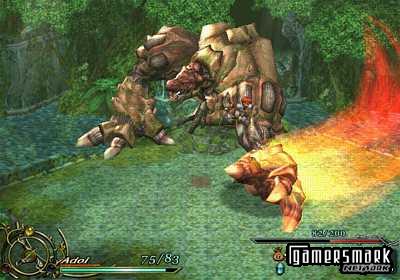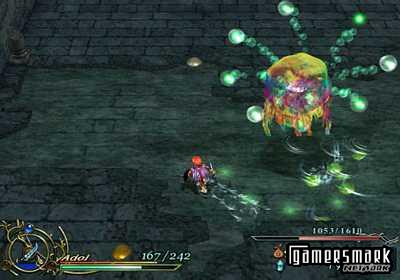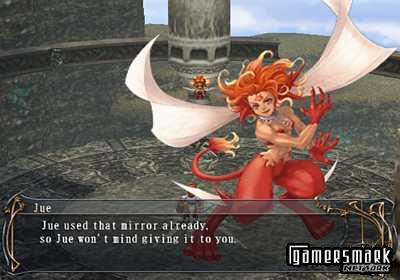Developer/Publisher: Konami || Overall: 7.6/10
The scene opens up with a tavern. A man with a patch over his eye and a pony tail walks into the noisy building from the cold night with a shorter companion by his side. The companion, shrouded in a cloak and with her face hidden simply follows the man. Across the way from the entrance of the tavern, a red-haired adventurer, named Adol, is sitting down with a friend of his. The man with the patch over his eye goes over to Adol, and asks him to accompany him on an exploration around the world. Just then, two soldiers come in, looking for the “red-haired Adol” wanting to arrest him! I don’t want to give away the crappiness of the introduction of the story to Ys: Ark of the Napishtim, so I’ll fast forward to my summary of the opening part of the story; the beginning of the story of Ys: Ark of the Napishtim is trash.
It’s not often that I exclaim obscenities when trying to understand what is trying to be conveyed, but it seems like the beginning of the story was tossed together as an afterthought. The beginning movie is pretty much the only movie the game has for the most part, and it’s badly voice acted. Though there were some very nice graphics exhibited, I counted about three instances of fan service, in which the underwear of the annoying-peppy-blonde-girl character that has some sort of crush (I’m guessing) on Adol is shown. They really know how to pack that kind of thing in. Had I rented the game, the beginning movie alone would make me seriously contemplate whether or not I should return it sooner than I had intended. However, what really saves this game from getting a horrible score is the game-play, and the story later on in the game actually helps it, as well (but after being in the gutter from the beginning, there’s nowhere to go but up, and the bad taste of a poorly set up story always lingers).
I would have to say what the main point of the game would be that it tries to pull off an “old-school” approach to gaming. Ys: The Ark of Napishtim seeks to accomplish this by having relatively simple controls, as well as old-style (but not completely crappy-looking) graphics, a silent main character, and the story itself just being set in a fantasy world (more specifically, the world of Ys, where all the games in the series has taken place). However, because of this “old-school” approach encased in the game, there are many enhancements over the games from back in the day. In Ys: The Ark of Napishtim, every single word displayed as dialogue from a character has a voice-over and rightly so. Every character, even the unimportant characters in a town you find in a back alley will have a voiced dialogue. The voice acting isn’t half bad, and everyone talks except for Adol himself. You’re just supposed to assume what he says by the one-sided conversations people have with him. However, there are a few instances (I think about ten times) where it says Adol “explains to (character) everything that has happened so far.” So, you’ll just have to assume that Adol tells them every single little part of the journey you had just been on, down to how many slime creatures you killed on the way over to see them. The only downfall with the voice acting is that there are a couple of very annoying characters (such as Professor Raba who talks in an over-exaggeratingly old-man’s voice), and that you can tell that there were only a few voice actors doing the voices for all the different characters.
At various times throughout the story you will meet characters (like Professor Raba) whom have met Adol in the past or have known him through his “legend” or whatever it is. I don’t even know what it is, because it made no sense to me when they talked about “when we were at the Tower of Whatshisface” or “you may not recognize me now since I’ve grown into a beautiful woman” and many other instances of back-story that are never actually explained. It was only until I researched the game a little bit online that I found out that this is the sixth game in the series. So it makes some sense as to why it came up repeatedly about people, places and events that seem to be completely random after knowing this fact. Even though it isn’t very important to the story of THIS game, it would have been nice to actually understand what they were talking about.
Story faults aside, the actual game that is inside Ys: The Ark of Napishtim is interesting to say the least. The main feature of the battle system is that there are three different elemental swords (wind, fire, and electricity). It’s up to you to use the swords to your liking, constantly “upgrading” them by collecting enough stones called “Emelas” (or Emel) so that you can use each sword’s special ability more often, or acquire the unique skill attached to the sword. Even though having three elemental swords implies (to me, at least) that there would be enemies that are immune to one sword but not another (forcing you to use the right sword to kill them), you will find this to not be the case for the most part. For how much the game relies on these three swords, it comes out to being which sword you fancy using the most. There are times where you can notice an increase in damage from one sword over another for a particular enemy, but all-in-all the swords were not used to create much of a type of strategy for playing the game. If it weren’t for the story actually requiring there be three swords, it would have been better to just have one sword with a bunch of different abilities. Other kinds of items in the backend system add to the game-play as well.
Unlike most RPGs, there aren’t hundreds of things to collect, rather just a few accessories, pieces of armor, items, event tools, and other such things that are somewhat rare. It gets to the point that it almost influences you to really look for as many items as you can and buy all the items you can. There are a lot of unique accessories to collect throughout the game that will make a big impact on the game itself, such as an accessory that will increase your HP by 50% or another that will increase your attack and defense a little bit. There are also EXP, Emel, and money enhancers so that you can milk out the highest amount of things from every enemy you beat. While you only start out with one accessory holder, you can find more throughout the dungeons, up to a total of five slots for accessories.
Like I said earlier, the whole game itself is very simple and the learning curve isn’t that long at all, and you’ll be able to master the fighting aspect of the game in no time, since the only button you really press is “Square.” Sometimes you press the “Circle” button to use a magic attack associated with the sword you’re using, but this is basically all that you do to fight. The “Square” button is also used to talk to townspeople and investigate treasure chests.
Although the game is pretty easy to learn and get into (playing-wise), there are a couple of annoyances here and there. A minor annoyance is that when you’re in the field or a dungeon, there is no on-screen map to help you find where you are in reference to the place you actually are at currently. So if you’re in a dark cave that is pretty much a maze, you might end up going in a circle or not remember how to get back to a particular part of the dungeon you had been to before but died in. However, the most annoying thing about the game is the bosses.
In all my years of playing video games, I have never seen such cheap, stupid bosses that literally make me throw my hands into the air and say “how do I beat this stupid freakin’ boss?” I understand that boss battles are an important part of any game, but these bosses are, for the most part, so out of place and so over the top in terms of what they can do to kill you that it’s practically amazing that I even beat some of them. Just to tell you what kinds of bosses you have to deal with, you fight a wall. You fight a wall with big, long, skinny, rock arms and a face that can launch flowers that blow up and shoot a large energy beam from its mouth, while swinging around the arms and slamming them on the ground so that rocks can fall from the sky to fall on top of you. If that’s not crazy enough for you, how about a big frog that can roll up into a bowling ball, crap out slime that makes you slide around, as well as use its tongue as a spiked-ball mace? Oh wait, I forgot to tell you that the frog has STEALTH CAMOUFLAGE – it can seemingly disappear! Even if you have the greatest skills in the world at playing this game, you will not beat any boss if you’re not at the right level. A general rule about boss battles is if you haven’t beat a boss after fifteen tries, level up at least five or ten levels, and you’ll see that the boss is all of a sudden a lot easier than they had been before. However, regardless of whether you’re even at the right level, it may take a couple of deaths to get a hang of what the boss actually does. You really can’t expect the things they pull out of the air when it comes to the boss’s abilities. Just when you think you figure out a boss, it surprises you with a new ability it hadn’t used the first time you faced it.
Regardless of all that has been said about the game, Ys: The Ark of Napishtim is a game that really grows on you. One may be displeased by the out-of-the-ordinary old-style graphics incorporated in the game or even the weird set-up for an underwhelming story full of references to past games in the series, but for those who suck it up and go on to actually try and complete the game, you’ll find the game to actually be fun, and actually get caught up in the story a bit. Being a title that is priced less than a “premium” title definitely may influence some people to pick up the game, especially if they are fans of the series (whom haven’t had a Ys game brought to North America since the Super Nintendo days). Even though the game doesn’t take very long to finish, you may end up spending around 20-25 hours on the game as a whole. For those that actually venture far enough as to beat the game, there are a few extras included in the game, which affect game play, audio, visuals, and other things that can be activated by entering the cheat code before playing a new game. In the end, however, Ys: The Ark of Napishtim may only appeal to fans of the series.



